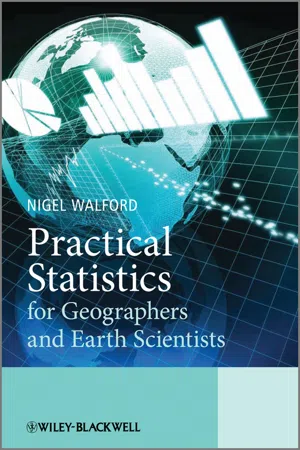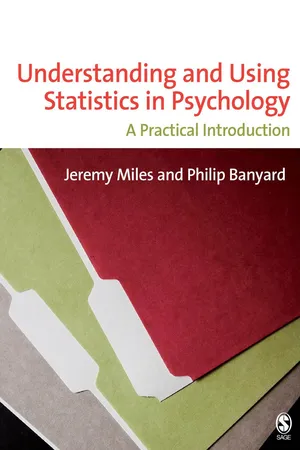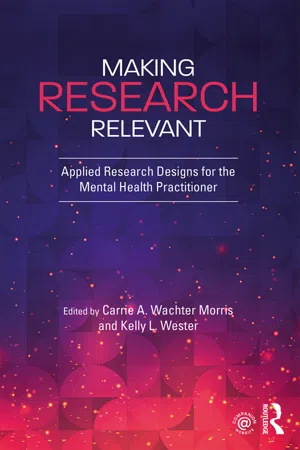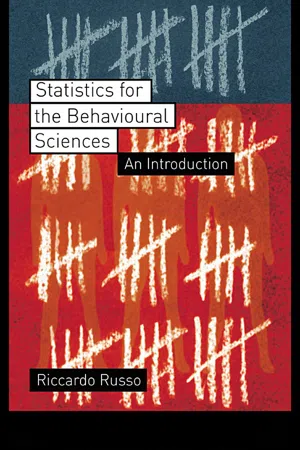Psychology
Correlation
Correlation in psychology refers to the statistical relationship between two or more variables. It measures the extent to which changes in one variable are associated with changes in another. A positive correlation indicates that as one variable increases, the other also increases, while a negative correlation suggests that as one variable increases, the other decreases.
Written by Perlego with AI-assistance
Related key terms
8 Key excerpts on "Correlation"
- eBook - ePub
- S Alexander Haslam, Craig McGarty(Authors)
- 2018(Publication Date)
- SAGE Publications Ltd(Publisher)
9 Examining Relationships between Variables: CorrelationKey goals for this chapter
- Introduce Correlation – a procedure for examining relationships between variables.
- Introduce Pearson’s r – a statistic that quantifies the nature and strength of the linear relationship between two variables.
- Explain how the results of Correlational analysis should be interpreted, with particular reference to the difference between Correlation and causation.
A lot of what we have talked about in the previous two chapters relates to comparisons between means, and comparing means is what psychologists typically do when they use experimental methodology. However, in a great deal of research investigators confront another interesting question: What is the relationship between two variables? For example, how is stress related to heart disease? How is socio-economic status related to mental health? How is personality related to the judgements people make?This type of question can be addressed by experiments (as in the previous chapter, where we used an example of the relationship between the amount of physical contact and attraction), but is more typically examined in surveys. In surveys the researchers collect information about variables where there may be many different values for each variable (in the attraction study, for example, lots of different levels of contact, not just two, and lots of different levels of attraction). Surveys also often measure two or more variables, each with multiple levels. We can contrast this with the case of a t-test where we have an independent variable with just two levels (a categorical variable) and a dependent variable with multiple levels.In survey research we often want to know whether two variables vary together. In other words, we want to determine whether there is an association between the variables. This is quite different from the example of the within-subjects t-test, where we are interested in the question of whether there are informative differences between participants’ scores on different measures. In this chapter we want to look at pairs of scores to see whether high scores are consistently associated with high scores (and low scores with low scores) or whether high scores are consistently associated with low scores. Where there is a relationship between variables that takes either of these two forms we say there is a Correlation - Nigel Walford(Author)
- 2011(Publication Date)
- Wiley(Publisher)
8 Correlation8.1 Nature of relationships between variablesLearning outcomes This chapter will enable readers to:Correlation is an overarching term used to describe those statistical techniques that explore the strength and direction of relationships between attributes or variables in quantitative terms. There are various types of Correlation analysis that can be applied to variables and attributes measured on the ratio/interval, ordinal and nominal scales. The chapter also covers tests that can be used to determine the significance of Correlation statistics. Correlation is often used by students and researchers in Geography, Earth and Environmental Science and related disciplines to help with understanding how variables are connected with each other.- carry out Correlation analysis techniques with different types of variables and attributes;
- apply statistical tests to find out the significance of Correlation measures calculated for sampled data;
- consider the application of Correlation techniques when planning the analyses to be carried out in an independent research investigation in Geography, Earth Science and related disciplines.
Several of the statistical techniques that we have explored in previous chapters have concentrated on one variable at a time and treated this in isolation from others that may have been collected for the same or different sets of sampled phenomena. However, generally the more interesting research questions are those demanding that we explore how different attributes and variables are connected with or related to each other. In statistics such connections are called relationships. Most of us are probably familiar, at least in simple terms, with the idea that relationships between people can be detected my means of analysing DNA. Thus, if the DNA of each person in a randomly selected group was obtained and analysed, it would be possible to discover if any of them were related to each other. If such a relationship were to be found, it would imply that the two people had something in common, perhaps sharing a common ancestor. In everyday terms, we might expect to see some similarity between those pairs of people having a relationship, in terms of such things as eye, skin or hair colour, facial features and other physiological characteristics. If these characteristics were to be quantified as attributes or variables, then we would expect people who were related to each other to possess similar values and those who are unrelated to have contrasting values.- eBook - ePub
Statistics in Social Work
An Introduction to Practical Applications
- Amy Batchelor(Author)
- 2019(Publication Date)
- Columbia University Press(Publisher)
5 THE STATISTICS OF RELATIONSHIPSA nalyzing relationships between variables that affect people is as important as analyzing relationships between people. Correlational methods help you better understand people, communities, and policy. If you are interested in what protective factors might help develop resilience in your client, Correlations help with that. If you have ever wondered whether a person’s income can help predict school outcomes for their children, Correlations help with that too. Or if you have ever wondered whether older adults who are lonely are more likely to experience poor health outcomes, Correlations can provide useful context there too. The relationships between these variables affect the people you work with, and Correlations help you analyze variables more effectively.LEARNING OBJECTIVES By the end of this chapter, you should understand the following concepts: • What Correlation is (and is not)• How to use the coefficient of determination • How to read scattergrams and Correlation tables Correlation• How to determine the strength and direction of a Correlation based on Pearson’s rCorrelation is the statistical analysis that describes the strength and direction of a relationship between variables. As discussed in chapter 1 , in your practice, you might hope that by increasing the number of counseling sessions a client attends (variable X), you will increase the reported happiness of your client (variable Y). Understanding how one variable is related to another is at the heart of your practice, regardless of the specific context you work in or the population you work with.You must always remember that even strong Correlations do not mean one variable caused - Martin Lee Abbott(Author)
- 2016(Publication Date)
- Wiley(Publisher)
CHAPTER 11 CorrelationCorrelation has an intuitive appeal. Most everyone understands that Correlation is concerned with whether changes in one thing are linked to changes in something else. Thus, for example, you may observe that wealthier people seem to have better overall health than those with lower wealth levels. Or, stated differently, as wealth increases, health increases as well.Correlation is a way of understanding the association between two variables. What does association mean? It refers to “relatedness” or the extent to which two events “vary with one another.” To use this language with the wealth–health example just cited, you might say that the increase in wealth (however it is measured) is accompanied by increases in health (according to its measures). In a general sense, you can say that the values of the one variable (health) change positively as the values of the other variable (wealth) increase. Thus, the values of both variables increase together, or “covary.”Not every Correlation is what it seems, however. There may be additional variables not taken into account in the analysis that give the original two variables the “appearance of covarying.” This possibility of spuriousness (see Chapter 2 ) hints at the complexity of a seemingly obvious relationship. Is it really wealth that results in health, or is it something (or things) else? In this and the following chapters on regression, I intend to explore this question further.The Nature of Correlation
I will examine Correlation in some depth in this chapter. It is a useful procedure for many reasons, and several methods of calculating Correlations exist that are adapted to the different natures of possible research questions.Explore and Predict
Evaluators use Correlation to explore the relationships among a series of variables they suspect may be important to a research question. Other evaluators may use Correlation to help predict- eBook - ePub
Understanding and Using Statistics in Psychology
A Practical Introduction
- Jeremy Miles, Philip Banyard(Authors)
- 2007(Publication Date)
- SAGE Publications Ltd(Publisher)
8
Relationships between variables: Correlation and regression
What’s in this chapter?
- Association
- Correlation
- Regression
- Interpreting Correlation and regression
- Calculating Correlation coefficients: Pearson and Spearman
- Causality
- Using SPSS
KEY TERMS
association causal relationship confidence interval Correlation coefficient covariance descriptive statistic dicohotomania equation for a straight line eugenics experimentinferential statistic Kendall’s tau-a line of best fit non-parametric Correlation normal distribution Pearson Correlation coefficient post hoc justification power proportion of variance regression line residual sample statistics scatterplot Simpson’s paradox Spearman Correlation standard deviation standardised slope statistical significanceFisher’s z transformationy-interceptINTRODUCTION
So far in this book we have considered ways of comparing groups of individuals. In particular, we have looked at differences between groups. All our hypotheses so far have been along the lines of whether one set of scores is bigger, wider, more frequent etc. than another set of scores. Not all data are like that and sometimes we don’t want to know about difference, we want to know about similarities or associations. For example, we might want to know if people who score higher on one measure also tend to score higher on another measure. This chapter looks at tests of association and how we can use them to predict scores.ASSOCIATION
In experiments we can assign people to one group of participants or one condition of the independent variable. We have control over who does what and we can use this control to draw some conclusions about the independent variable. If we want to find out about the effects of alcohol on mood, we can divide our participants into two groups, give one group unlimited alcohol for a week and compare the moods of the two groups. This is an experiment - eBook - ePub
SPSS Survival Manual
A step by step guide to data analysis using IBM SPSS
- Julie Pallant(Author)
- 2020(Publication Date)
- Routledge(Publisher)
Part Four of this book. I would strongly recommend that you read through that material before proceeding with the remainder of this chapter.Details of Example
To demonstrate the use of Correlation, I explore the interrelationships among some of the variables included in the survey.sav data file provided on the website accompanying this book. The survey was designed to explore the factors that affect respondents' psychological adjustment and wellbeing (see the Appendix for a full description of the study). In this example, I am interested in assessing the Correlation between respondents' feelings of control and their level of perceived stress. If you wish to follow along with this example, you should start IBM SPSS Statistics and open the survey.sav file.Example of research question: Is there a relationship between the amount of control people have over their internal states and their levels of perceived stress? Do people with high levels of perceived control experience lower levels of perceived stress?What you need: Two variables: both continuous, or one continuous and the other dichotomous (two values).What it does: Correlation describes the relationship between two continuous variables, in terms of both the strength of the relationship and the direction.Assumptions: See the introduction to Part Four .Non-parametric alternative: Spearman Rank Order Correlation (rho).Preliminary Analyses for Correlation
Before performing a Correlation analysis, it is a good idea to generate a scatterplot. This enables you to check for outliers and for violation of the assumptions of linearity (see introduction to Part Four ). Inspection of the scatterplots also gives you a better idea of the nature of the relationship between your variables.To generate a scatterplot between your independent variable (Total PCOISS) and dependent variable (Total perceived stress) follow the instructions detailed inChapter 7 - eBook - ePub
Making Research Relevant
Applied Research Designs for the Mental Health Practitioner
- Carrie A. Wachter Morris, Kelly L. Wester(Authors)
- 2018(Publication Date)
- Routledge(Publisher)
Many different analyses are appropriate for a Correlational research design. These include but are not limited to Correlations, regressions, and path analysis. We will not go in depth into all of these analyses, but know that they are all used for different reasons and ultimately may depend on how many variables you are comparing. What underlies each of these analyses is the Correlation, so we are going to focus solely on the Pearson Correlation coefficient (but note that there are many other Correlation coefficients available as well).Pearson Correlation Coefficient (r)
This is a measure of the strength of the relationship between two variables. The r-value will consist of (1) a numerical value ranging from -1 to 1 and (2) a positive or negative sign. These values correspond to the strength and the direction of the relationship. More specifically, a positive or negative sign indicates the direction of the association, and the r-value itself indicates the strength of the association; thus, the higher the absolute numerical value the stronger the relationship, with an r-value of (0.00) representing no relationship, an r-value of (±0.50) representing a moderate relationship, and an r-value of (±0.90) representing a strong relationship.Visual Expression of Your Data
Providing your data in a scatterplot will allow for a visual understanding of the strength and direction of the relationship. The scatterplot graph can be created by plotting both values of social support and anxiety for each individual. There is no specific requirement for which variable goes on which axis. After the data have been plotted, the best-fit line will be drawn to visually see the linear relationship between the two variables more clearly (see Figure 7.1 ).Interpreting Your Results
The interpretation of the results is structured based on the strength and direction of the relationship of the Correlation. For a positive relationship, as one variable increases, the other variable increases as well. For a negative relationship, as one variable increases, the other variable decreases. The results of a Correlational design can only inform researcher about the relationship, but the results do not infer causality of the relationship. In other words, a Correlation would not imply that one variable causes another variable but rather would describe the relationship between the two. - eBook - ePub
Statistics for the Behavioural Sciences
An Introduction
- Riccardo Russo(Author)
- 2004(Publication Date)
- Psychology Press(Publisher)
Chapter 11 Correlation Introduction Researchers often need to collect measurements on pairs of variables because they want to study their relationship. For example, in the section on pages we described a study where subjects were given words and pictures to commit to memory. It appeared that the mean number of pictures remembered was significantly larger than the mean number of recalled words. Thus, different means corresponded to different levels of the independent variable (i.e., treatments). Looking at this result from a slightly different perspective, we can say that the means were related to the treatments. This example indicates that speaking about differences between treatment means is the same as saying means are related to treatments. In this chapter we will describe how to calculate indices to measure the strength of the relationship between two variables, where these variables can be measured using different types of numerical scale. In the section on pages we have already met one of these indices, i.e., ø, which is used to measure the strength of a relationship between two dichotomous variables in 2 × 2 contingency tables. This chapter will mainly focus on the Pearson product-moment Correlation coefficient r and other associated indices. Pearson’s r measures the strength of the linear relationship between two continuous variables. In this chapter we will also describe measures of association suitable for ranked data. Linear relationships between two continuous variables Consider the case where a researcher collects a series of measurements on two continuous variables X, the mark obtained in the undergraduate degree, and Y, the monthly salary, in pounds, at the end of the third year after graduation, in a sample of former university students now currently employed. This researcher’s aim is to investigate if there is a positive linear relationship between grades and salaries
Learn about this page
Index pages curate the most relevant extracts from our library of academic textbooks. They’ve been created using an in-house natural language model (NLM), each adding context and meaning to key research topics.







